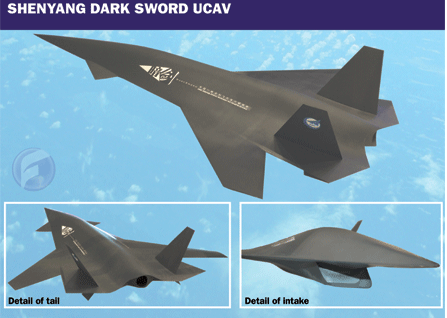Almost a year on from its unveiling at the November 2006 Zhuhai air show and reappearance at this year's Paris air show, the Shenyang Aircraft Design and Research Institute's "Dark Sword" concept for an unmanned combat air vehicle continues to pose questions for Western analysts about its proposed role.
Initially portrayed by Shenyang as being intended for air-to-air superiority roles, the design reflects an amalgam of concepts that in turn open the way for multiple interpretations of its real purpose. The design is variously seen as reflecting technical lag in Chinese aerospace industry capabilities compared with the West as a chimera intended to help equalise perceptions of Chinese capability or in more recent thinking, as an early harbinger of possible long-range strike platforms.

The Dark Sword model portrays an elongated delta airframe with highly swept aft-mounted wings. It has four cantilevered tail fins, the larger two of which are mounted at the top of the main delta wing, with the other two mounted beneath. The forward fuselage is dominated by an extremely large belly-mounted intake and two apparently retractable canards.
No size or powerplant notions have been released for the design. The large intake is consistent with Western concepts for fourth-generation turbofan-powered fighters optimised for use in close combat roles. Its shape also clearly reflects a desire to reduce radar cross section, but its location and size is at odds with the bulk of Western thinking about UCAV signature suppression, which has seen the uniform adoption of above-fuselage intakes. It also contrasts with other notional Chinese UCAV designs that have emerged from the nation's AVIC 1 industrial grouping, with these tending to illustrate air vehicles similar to those now under development by European and US industry.
The aircraft's rear fuselage poses other questions: unlike the rest of the airframe, the area around where the engine nozzle would be located has simply been left as a vertical surface with a recess indicating the exhaust. This contrasts with the considerable efforts made at streamlining the remainder of the design, as it would generate considerable drag.
The inclusion of the canard surfaces reiterates the development links between current Chinese manned fighter aircraft. Western UCAV designs in contrast rely on inherent airframe instability and advanced fly-by-wire controls, leading to completely tailless configurations. However, all current Western UCAV designs are optimised for suppression of enemy air defences, rather than air-to-air combat, which is seen as a long-term operational capability, rather than an immediate development priority. In this respect the Dark Sword concept is being pitched against a mission that Western developers do not expect to emerge for at least another two decades.
If Dark Sword is a future air-to-air combatant, its emphasis on control surfaces is indicative of a type that would be capable of highly dynamic operational performance if developed using current Chinese technologies. However, if manufactured, its debut flight would come at a time when Chinese industry is likely to have parity with current Western avionics, and could therefore offer an air vehicle noticeably cleaner in profile and provide advanced manoeuvrability. That "break" between expected technical capability development and the Dark Sword concept is perhaps the strongest grounds on which to dismiss the model as a chimera.
It is as an illustration of Chinese thinking about high-speed long-range strike, however, that the model offers the most interesting interpretations. Dark Sword has an uncanny resemblance to a variety of conceptual very high supersonic and hypersonic air vehicle designs which circulated in Western circles in the late 1980s, particularly those powered by ramjets.
Ramjet propulsion would explain not only the large intake and its positioning, but also the abrupt termination of the aft fuselage, as any airflow cavity caused by the design would be rendered meaningless by the sheer speeds being travelled. It would also explain the multiple control surfaces and in particular the underside fins to assist in manoeuvring in extremely thin atmospheric conditions.
The canard surfaces would have application in low-speed profiles, but by retracting would significantly reduce drag in the deployment phase of a mission. An aircraft of this type would have extremely long range and be capable of meeting very rapid deployment goals, and conceivably could then support air-to-air operations after reaching its deployment area.
In that context Dark Sword hints at an operational concept that has little to do with operations in the near vicinity of China, and is instead part of developing ideas for the conduct of extremely long-range deployments followed by highly dynamic operations. That concept is equally technologically challenging, but has a precursor in previously seen Chinese military ideas for being able to engage a future adversary at extreme distances.
Source: Flight International













